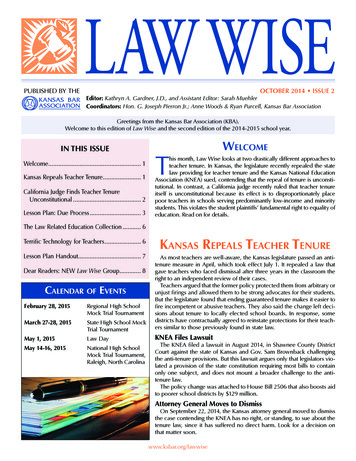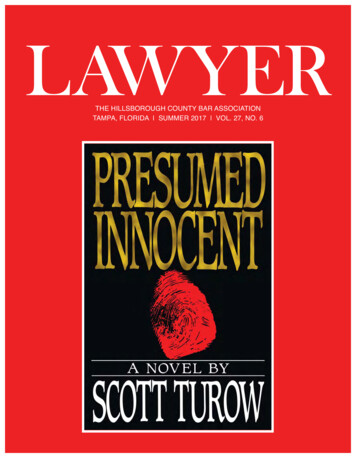
Transcription
PUBLISHED BY THELAW WISEOCTOBER 2014 ISSUE 2Editor: Kathryn A. Gardner, J.D., and Assistant Editor: Sarah MuehlerCoordinators: Hon. G. Joseph Pierron Jr.; Anne Woods & Ryan Purcell, Kansas Bar AssociationGreetings from the Kansas Bar Association (KBA).Welcome to this edition of Law Wise and the second edition of the 2014-2015 school year.IN THIS ISSUEWelcome. 1Kansas Repeals Teacher Tenure. 1California Judge Finds Teacher TenureUnconstitutional. 2Lesson Plan: Due Process. 3TWelcomehis month, Law Wise looks at two drastically different approaches toteacher tenure. In Kansas, the legislature recently repealed the statelaw providing for teacher tenure and the Kansas National EducationAssociation (KNEA) sued, contending that the repeal of tenure is unconstitutional. In contrast, a California judge recently ruled that teacher tenureitself is unconstitutional because its effect is to disproportionately placepoor teachers in schools serving predominantly low-income and minoritystudents. This violates the student plaintiffs’ fundamental right to equality ofeducation. Read on for details.The Law Related Education Collection. 6Terrific Technology for Teachers. 6Lesson Plan Handout. 7Kansas Repeals Teacher TenureMarch 27-28, 2015 State High School MockTrial TournamentAs most teachers are well-aware, the Kansas legislature passed an antitenure measure in April, which took effect July 1. It repealed a law thatgave teachers who faced dismissal after three years in the classroom theright to an independent review of their cases.Teachers argued that the former policy protected them from arbitrary orunjust firings and allowed them to be strong advocates for their students.But the legislature found that ending guaranteed tenure makes it easier tofire incompetent or abusive teachers. They also said the change left decisions about tenure to locally elected school boards. In response, somedistricts have contractually agreed to reinstate protections for their teachers similar to those previously found in state law.May 1, 2015KNEA Files LawsuitDear Readers: NEW Law Wise Group. 8Calendar of EventsFebruary 28, 2015 Regional High SchoolMock Trial TournamentLaw DayMay 14-16, 2015 National High SchoolMock Trial Tournament,Raleigh, North CarolinaThe KNEA filed a lawsuit in August 2014, in Shawnee County DistrictCourt against the state of Kansas and Gov. Sam Brownback challengingthe anti-tenure provisions. But this lawsuit argues only that legislators violated a provision of the state constitution requiring most bills to containonly one subject, and does not mount a broader challenge to the antitenure law.The policy change was attached to House Bill 2506 that also boosts aidto poorer school districts by 129 million.Attorney General Moves to DismissOn September 22, 2014, the Kansas attorney general moved to dismissthe case contending the KNEA has no right, or standing, to sue about thetenure law, since it has suffered no direct harm. Look for a decision onthat matter soon.www.ksbar.org/lawwise
2 LAW WISE OCTOBER 2014OCalifornia Judge Finds Teacher TenureUnconstitutionaln June 10 of this year, Los Angeles County SuperiorCourt Judge Rolf Treu held tenure and other job protections for California’s public school teachers unconstitutional because they violated the Equal Protection Clause of theU.S. Constitution. California’s law granted tenure after just 18months.Judge Treu cited Brown v. Board of Education’s ruling thatall students are entitled to equal education and found the lawdiscriminated against minority and low-income students. Hefound that the teacher tenure law resulted in a significant number of “grossly ineffective teachers” obtaining and retainingpermanent employment, and that such teachers are disproportionately situated in schools serving predominantly lowincome and minority students. This violated the student plaintiff’s fundamental right to equality of education. But the judge’sruling has been stayed pending an appeal.The suit, Vergara v. California, was brought by nine students(Beatriz Vergara), backed by the nonprofit group, StudentsMatter, founded by David Welch, a 52-year-old Silicon Valleybillionaire.Similar Lawsuits are Filed in New YorkAfter Judge Treu’s decision, two lawsuits similar to the California lawsuit were filed in New York against the state of NewYork and its Board of Regents. New York requires teachers toserve a three-year probationary period, which can be extended to up to four years, before gaining tenure. The lawsuits werebrought by groups of low-income families who claim theirchildren are being stuck with second- or third-rate teachers,violating their right to equal education under the law. The suitsallege a statewide systemic failure, not specific to any district.Both argue that job protections for teachers make it essentiallyimpossible to fire incompetent educators, violating students’constitutional right to a “sound, basic education” under ArticleXI of the New York state Constitution.The Albany action is being done pro bono on behalf of agroup of parents organized by the Partnership for Educational Justice, an advocacy group founded by Campbell Brown,a former CNN host. The other suit, Davids v. State of NewYork, was filed in Staten Island Supreme Court by Mona Davids, president of the New York City Parents Union. That suitis now funded by Welch’s advocacy group which funded theCalifornia case. Attorney Theodore Boutrous, who argued theCalifornia case, says:We plan to show that New York’s current education systemdoes not serve the needs of kids and in fact prevents themfrom accessing a sound education The system createdby New York’s laws restricts access to quality teachers anddetracts from the overriding purpose of New York’s education system: to serve the best interest of students.Teachers’ Union Seeks to InterveneNew York State’s largest teachers’ union moved to intervenein the above cases. Karen Magee, president of the State UnitedTeachers, said tenure is far more apt to protect teachers whotake unpopular positions with their employers by advocatingfor education improvements than it is to protect incompetentteachers. Magee, a former special education teacher in Harrison, New York, said it is not unusual for teachers to incur thewrath of school districts by arguing that they spend more onstudents and better facilities. “Tenure is a due process right,”Magee said. “It takes away nepotism and favoritism. It takesaway patronage. It causes a district to do their due diligencewhen deciding if teachers are worthy of tenure.”Did You Know?1. Before Massachusetts introduced teacher tenure in 1886,women were sometimes dismissed for getting married, becoming pregnant, wearing pants, or being out too late inthe evenings.2. In a June 1, 2009, study by the New Teacher Project, 86percent of school administrators said “they do not alwayspursue dismissal” of poorly performing teachers becauseof the costly and time consuming process.3. California Gov. Arnold Schwarzenegger called a specialelection for November 8, 2005, that included Proposition74, which would have extended the time before a teacherbecomes tenured from two to five years. In response, theCalifornia Teachers Association increased member fees by 60, raising 50 million to fight Proposition 74. The proposition failed, receiving 45 of the vote.4. On June 28, 2010, New York City closed its “rubberrooms,” where approximately 600 tenured teachers “accused of incompetence and wrongdoing” receivedtheir full salaries to sit in a sparse room and do n.us/1tyang0The N.Y. cases have since been consolidated so will be considered together.www.ksbar.org/lawwise
OCTOBER 2014 LAW WISE 3DLe s s o nu el a nProc This lesson from the American Bar Association consists of: Introduction: Teaching about Due Process Handout: Bill’s Bad Day (Scenario – last page of Law Wise) Questions Due Process GraphIntroduction“Due process” may be unfamiliar to students unless they’vebeen studying law already. Here are some ways to effectivelypresent this very important idea to secondary students.Teachers could use this lesson over several class periods. Oryou could adapt it to focus on the general principle of dueprocess, and use just some of the specific examples given inquestions 4-10. Cites have been provided to help presenters (orstudents) who want to do additional research.The teacher or presenter can use the following scenarioand questions with the full class, or break the class into smallgroups which could report back to the whole class. Additionalactivities could include role playing certain situations.Opening ScenarioThe Due Process Clause in the U.S. Constitution reads: “norshall any State deprive any person of life, liberty, or property,without due process of law.” What does “due process of law”mean? What rights does it provide to people, and what obligations does it require from government? The following scenario[Bill’s Bad Day] sets out a number of matters that have to dowith the due process of law. You might want to photocopy itand hand it out to students to begin the lesson.Bill’s Day Off Handout (Link below or P. 7)QUESTIONS1. Can the government do that?PThe scenario (http://bit.ly/KBA LW DueProcess) poses arange of takings and intrusions, from minor to extremely serious. The key point of the lesson is that the government canonly deprive a person of life, liberty or property in accordancewith due process of law. That begs the question, “What is dueprocess of law?”Distilled to its essence, due process requires notice andan opportunity to be heard. Stated another way, due processmeans that the government must indicate some justification orcause for its actions and must give attention to and take seriously the response or position of the person being affected.The starting point of due process analysis in each of the abovesituations, then, is to identify the government’s authority orreasons for its actions.In each of the instances in “Bill’s Bad Day,” the governmentor community has interests it seeks to enforce against the person. For instance, in the case of the school suspension, theschool’s interest is to maintain a learning environment. Gossv. Lopez, 419 U.S. 565 (1975). In the case of the death penalty, the government’s interest is to punish and prevent seriouscrime.e s sGrades: 9–12 (high school)2. What could happen to me?The second step in the analysis is determine how much process is due in a given situation. The key concept is that dueprocess is not a rigid set of identical rules for all situations, butflexible procedures varying with the situation. Basically, dueprocess depends on an assessment of the balance betweenthe degree of the loss a person could possibly suffer and theimportance of the government’s interest, including the cost ordifficulty in providing the process. Mathews v. Eldridge, 424U.S. 319 (1976). In the [scenario] instances, the possible lossranges from missing a few days of school to losing one’s life.Teaching point: After examining the scenario’s situations,the teacher or presenter can ask students to identify the government interests and their importance, then to identify theperson’s interest and its importance, and the degree of the possible loss.3. What can I do about it?The issues here are what procedures or safeguards are provided by the government in the way of justifications and opportunity to respond, and whether they are adequate. In general,this requires an assessment of the government’s and person’sinterest, discussed above, and “risk of an erroneous deprivation of [a person’s] interest . and the probable value, if any,of additional or substitute safeguards. .” Mathews v. Eldridge,424 U.S. 319, 321 (1976).The possible procedures may include the following: right to afree or retained lawyer, a formal trial and rules of evidence, opportunity to call witness or to cross-examine, appeal, impartialjury, prompt hearing, public trial, burden of proof, transcript,written opinion or decision stating facts relied on, informalhearing, written notice of charge or pending government action, arraignment or presentment, bail, independent review ofexecutive action by judiciary (e.g., search warrant), standardfor intervention (e.g., reasonable suspicion, probable cause),statement of rights (e.g., at preliminary hearing and Mirandawarnings) and specified procedures, including setting of mitigating and aggravating circumstances, a separate sentencinghearing, and an elaborate appeals process (death penalty). See18 U.S.C.A. 3591-3595 for specific federal protections in federal death penalty cases.Teaching point: Ask students to brainstorm or list the dueprocess protections they are aware of. To prompt some ideas,ask them to read the fourth, fifth and sixth amendments, recall a case they are familiar with, watch a video clip (e.g., ascene from “Gideon’s Trumpet” or more recent film) or readan appropriate newspaper article. Once you have a list, havestudents work in pairs to classify the protections, e.g., as “essential, very important, not so important.” Another approachwould be to make a sixth amendment “ladder,” a paper withsix lines or steps; ask them to put the most important on thetop rung or step, the next most on the second rung, and so on.www.ksbar.org/lawwise
4 LAW WISE OCTOBER 2014The issue of what process is due for any particular situationis developed in the more specific student questions, which follow below:4. D oes a person have to talk with the police ifthey ask her questions?The fifth Amendment provides that “no person . shall becompelled in any criminal case to be a witness against himself. .” This basically means that a person doesn’t have to talkwith the police at any time in any situation that may implicateher in criminal activity. If a person reveals a criminal act to athird party, say a friend, that friend can be compelled to testifyagainst the person, however. If the police have a suspect incustody, they must inform her of her constitutional rights toremain silent and to representation by a lawyer before theyask her any questions. Known as the Miranda warnings, thisinformation is essential before an interrogation because the inherently coercive nature of police custody casts doubt on thevoluntariness of a suspect’s statement. Miranda v. Arizona, 384U.S. 436 (1966).In contact with law enforcement officers at earlier stages inan investigation or street encounters, a person need not respond to questions or make statements, although to facilitatelaw enforcement one may agree to do so. See U.S. v. Wylie, 186U.S. App. D.C. 231, 236, 569 F.2d 62, 67 (1977), cert. denied,435 U.S. 944 (1978). In Wylie, a police officer monitoring abank noticed a customer acting unusually when trying to makea withdrawal. The police offer asked, “Sir, may I talk to you fora moment,” and after becoming more suspicious, “Would youmind coming back inside the bank with me, and we will talkwith the manager. .” The court found that the conversationwas not a “stop” but a “contact,” and that Wylie would havebeen free to go if he did not answer the questions. When Billis questioned at his doorstep by the IRS agent, in the exampleabove, he is not required to answer questions. Miranda warnings are not required at that point, however, and any statementBill makes can be used as evidence by the government.Teaching point: Role play Bill’s response to the police seeking to search the house and to the IRS agent wanting to question him about his taxes.5. W hen can I have a lawyer? Do I have to pay forthe lawyer?In criminal cases, the right to counsel has come to mean thatevery defendant has a right to a lawyer to assist in her defense,and that a defendant who cannot afford lawyer will have oneappointed for her. Gideon v. Wainright, 372 U.S. 335 (1963).In cases where no imprisonment is possible, such as traffic offenses, defendants may hire lawyers for their defense but theyare normally not provided for free, on the theory that no lossof liberty is involved. In certain non-criminal cases where theloss may be severe, such as in charges of child abuse or neglector termination of parental rights, many jurisdictions will appoint counsel for defendants who cannot afford them, as wellas counsel to represent the children’s interests. This is largelybecause adjudications of abuse and neglect could result in thechild being removed from the home. See, e.g. 16 D.C. Code2304 (b) (1) and (b) (3).6. W hen can the police search a person’s home orbody?While a full discussion of search and seizure law is beyondthe scope of this lesson, some useful generalizations can bemade in connection with due process. Essentially, the government must have greater degrees of justification for greater degrees of intrusion into one’s liberty. For instance, the government needs a search warrant, based on probable cause andspecifying what is to be searched and seized, approved by thejudicial branch before conducting a search in a person’s homeor of his body, or anything in which he has an “reasonable expectation of privacy,” Katz v. U. S., 389 U.S. 347 (1967), unlesscertain exceptions arise.One set of exceptions has to do with the safety of the policewhen questioning or arresting a suspect. When the police have“reasonable, articulable suspicion” that a person may be committing a crime, they may stop and question the person, andmay pat down or frisk the person’s outer clothing for weapons.This is known as a stop and frisk, or Terry stop, after Terry v.Ohio, 392 U.S. 1 (1968). Police may search a person incidentto his arrest, or conduct a protective sweep of a house beingsearched, for safety reasons also. For related safety reasons,searches may be conducted at airports.The second set of exceptions has to do with other justifications for suspending the warrant requirement, such as “hotpursuit” when pursuing a suspect into a house, “emergencies”such as responding to a fire or call for help, “consent” whenthe police are given permission to search, and “plain view”when the violation of the law is observed from where the police are entitled to be and where other persons could observeit. In these instances, there is diminished interest in privacy andlittle, if any, loss of liberty or property rights attributable to thesearch. Put another way, the intrusion is justifiable on groundsother than a search; the discovery of the illegality is incidentalto the intrusion. In a sense, these discoveries are not “searches”at all.7. When can the police search my car?People have a high expectation of privacy in cars, as they doin their homes and in their persons. Because cars are mobile,however, police have greater necessity to secure and inspecta car that may be involved in a crime or investigation, so theyoften may search a car without a warrant and without probablecause. For instance, police may do an inventory of a car before they impound it. Marijuana discovered in the glove compartment during the inventory can be used as evidence. SouthDakota v. Opperman, 428 U.S. 364 (1976). Police cannot gobeyond the purpose of the inventory, though, to open a lockedsuitcase. Florida v. Wells, 495 U.S. 1 (1990).During an arrest of a person in a car, other occupants andthe accessible interior of the car may be searched for the safetyand protection of the police, as a search incident to an arrest. Similarly, police can search the accessible interior of a carstopped for suspicious behavior and its occupants for protective reasons, as in a Terry stop. Going beyond this, however,would be a violation of the fourth Amendment.www.ksbar.org/lawwise
OCTOBER 2014 LAW WISE 5Teaching point: To begin instruction on this point, ask students how they feel about privacy in their cars, compared toprivacy in their homes. What difference does it make that carsare more mobile? What about the fact that the interior of acar and its occupants are plainly visible to someone standingoutside?8. Can the school search me or my locker?The key to understanding due process rights and obligationsregarding searches by school authorities lies in appreciationof the special circumstances of schooling and the relationship between students and school authorities. First, schoolshave special responsibilities regarding students. The purposeof schools is to educate students, and to this end schools areempowered to establish and enforce rules to support a learning environment. To a certain degree, schools act in the placeof parents, so have an obligation for the safety and moral andeducational development of students in their care. For thesereasons, school authorities have a high interest in order andproper behavior. Moreover, elementary and secondary students are typically minors, and in any event are seen as havingdeveloping, but not fully developed, capabilities, interests, andrights. Also, students have lower expectations of privacy whileon school property.The leading case in this area is T.L.O. v. New Jersey, 469 U.S.325 (1985), where the Supreme Court allowed a school principal to search a student’s purse for prohibited cigarettes afterthe student was observed by a teacher to be smoking in a bathroom. The principal did not have “probable cause” to searchthe purse, the standard that would have been required outsidethe school. Inside the school to maintain school rules, however, the principal could search with a lesser degree of certaintythat the student committed an offense, i.e., with “reasonablesuspicion” under the circumstance. In the case of a search ofa student’s locker, a key consideration would be the student’sexpectation of privacy. For instance, were the students permitted to use their own locks or did the school possess keys toopen all lockers? Did the school publish a policy that lockerswere not private student areas?In a more recent case, the Supreme Court allowed schoolauthorities to conduct random drug tests — that is, searches without any cause whatsoever — of student athletes. TheCourt justified its ruling on the notions that the students had diminished expectations of privacy in the school, the school hada strong interest in promoting proper behavior and preventingdrug use, particularly of athletes, and that the tests were notvery intrusive in students’ privacy. Vernonia School District 47Jv. Acton, 515 U.S. 646 (1995). A similar analysis should applyin the instance of metal detectors in schools or random lockersearches.9. W hat protections does due process requirewhen the government tries to take away abenefit or other interest?The protections required by due process depend on the balance of the factors set out in Mathews v. Eldridge, above. Incases of welfare, employment or social security benefits, inwhich the recipient is dependent upon the benefits for his/her livelihood, the protections required are substantial. For instance, in Goldberg v. Kelly, 397 U.S. 254 (1970), the statutoryentitlement of welfare benefits was considered “property,” andtheir withdrawal was protected by the opportunity of an administrative hearing, with adequate notice, and the ability topresent evidence and cross-examine adverse witnesses, beforebenefits were terminated. Similar protections are provided forother significant interests, such as a parent’s relationship to herchild.For instance, the Prevention of Child Abuse and Neglect Actof the District of Columbia created a statutory structure thatpermits the government to remove children from families onlywhen the children are endangered, and only then in conjunction with substantial procedural protections, such as prompthearings and appointed counsel. For instance, the city canonly remove a child from parental custody on an emergencybasis when they have reasonable belief that the child is in “immediate danger” and removal is “necessary,” and a hearingmust be provided the next day to justify the continued removal “to protect the person of the child.” To determine whetherparents are committing child neglect, the government mustconduct a formal hearing. A second hearing is required to determine what the government can do to remedy the situation;the government is required to provide appropriate services tothe family, and can only remove the child as a last resort if thechild can’t otherwise be protected. See 16 D.C. Code 2301 et.seq. (1995).In other situations where the deprivation of a constitutionallyprotected interest is less severe, protections are correspondingly less. In the case of a suspension from school for less than tendays, the school authorities only need to provide the studentwith notice of the charge and evidence against her, and to listen to the student’s version of the story, before the suspension.See Goss v. Lopez, above.10. How does this whole idea of due processwork?It would be great if students would ask this question. To helpthem grasp the notion of the flexible and relative nature of dueprocess, they could participate in the making of a graph thatshows due process protections as one axis and the situationsrequiring due process along the other axis. The basic conceptof the chart is reproduced here. Students should see, after constructing the chart, that due process is provided relative to thesituation.Teaching Point: The key to this part of the lesson is that thestudents should construct the graph or chart based on theirunderstanding of the lesson. Thus, the chart serves both toevaluate what the students have learned and to instruct re therelative nature of due process. To have students construct thegraph, first ask them to pin down the two extremes of the bottom axis, the deprivation/government interest axis. Ask: Whatis the most serious loss a person could suffer at the hands ofthe government? Answer: one’s life, or the death penalty. Whatis the least serious government intrusion? There may be somedebate on this, but many would say a simple contact is least(although highly intimidating for some), certainly when compared to other more intrusive interventions. Next, elicit theprotections afforded with respect to the possible deprivations,and place them on the board. This should construct a chartsomething like on the following page.www.ksbar.org/lawwise
6 LAW WISE OCTOBER 2014The Law Related Education Collection@ the Teachers College Resource Center, Emporia State UniversityThe right to vote is a topic that gets lots of attention whenElection Day rolls around. This topic seems largely taken forgranted, unless you are a student of the Constitution, or lackvoting rights. To support this topic, we have several materialsavailable, one of which is new. “The Election Process in America” DVD, has been purchased by the Kansas Bar Association,and placed here at the Center for use by students and educators. In this 50-minute documentary, the viewer will learnthat there are more constitutional amendments dealing withelections and voting than with any other aspect of our government. Students at the high school level and above wouldbenefit most from this resource.If this topic fits your interests or needs, you may search online at emporiastate.worldcat.org and choose “Resource Center” from the Dropbox to see the full array of materials andresources available here at the Center. If you plan to be in ourarea, we are located on the second floor of Visser Hall, on theCampus of Emporia State University, and we would be proudto give you the guided tour. You may also call (620) 341-5292to check out resources during our hours, 9 a.m. to 6 p.m.,Monday through Thursday, and 9 a.m. to 5 p.m. on Friday. Weare able to mail out and receive items with no charge to thepatron, thanks to the generosity of the Kansas Bar Association.Please help us to continue our “Buzz” here at the Law RelatedEducation Collection at Emporia State University!Janice Romeiser, Director,Teachers College Resource Centerjromeise@emporia.eduTe r r i f i c Te c h n o l o g yWant to see what both sides of the debate on teacher tenurehave to say? Check out Teacher Tenure Debate: Pros & nsIs teacher tenure the best way to attract talent to the profession, or something that prevents principals from giving kidstheir best chance at success? Should teachers have tenure?Two heavy hitters in the education field weigh in on thepros and cons. Geoffrey Canada, educational activist andpresident of Harlem Children’s Zone, argues no, while johnWilson, executive director of the NEA, argues /forTe a c h e r sThis site has a wealth of information about the pros andcons of teacher tenure, state-by-state time to tenure, k-12teacher salaries, and interesting facts, such as in the “DidYou Know” on .http://teachertenure.procon.org/Are you curious about the history of teacher tenure? Thencheck out this link for a brief -debate/Interested in a reform that both sides might be able to agreeon? Read about restructuring teacher pensions here.http://wapo.st/1od2YRbwww.ksbar.org/lawwise
Bill’s Bad Days he sits in his living room one afternoon, BillAencounters a string of problems. His teenage sonis sent home from school, suspended for three days.In the mail, Bill receives three letters. The first, fromthe state government, informs him that the state isThere is no note or reason given for the suspension. building a highway where his house is located. Itplans to take it and give Bill 100,000, half of whatThe police knock at the door, wanting to search his Bill thinks it is worth. The second, from his employer,the city government, notifies him that he is fired fromhouse. They don’t have a warrant.his job, due to a recent conviction
Similar Lawsuits are Filed in New York After Judge Treu's decision, two lawsuits similar to the Cali-fornia lawsuit were filed in New York against the state of New York and its Board of Regents. New York requires teachers to serve a three-year probationary period, which can be extend-ed to up to four years, before gaining tenure. The lawsuits .










